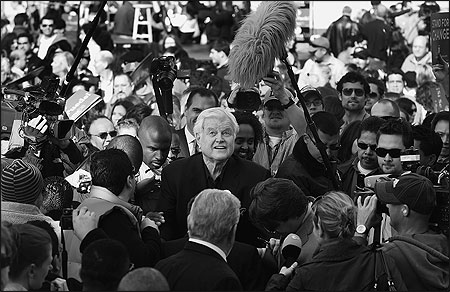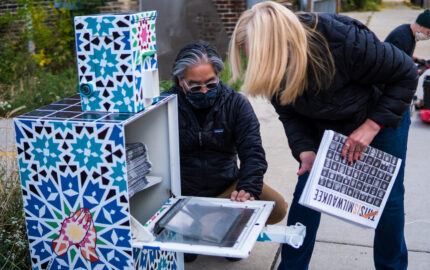
To understand how PolitiFact is different from other kinds of political journalism, consider this:
- It's edited by committee.
- We're especially proud of the stories we did not publish.
- We say politicians are liars.
PolitiFact (www.politifact.com) is a fact-checking Web site that the St. Petersburg Times launched last summer with help from our corporate sibling, EDITOR'S NOTE
The St. Petersburg Times Staff received a 2009 Pulitzer Prize in National Reporting for “PolitiFact.”Congressional Quarterly. It takes fact checking to a new level, because we make rulings on whether a candidate's claims are true, false or somewhere in between.
We fact check every significant claim made in the presidential campaign — from speeches, TV ads, statements in debates, and even bloggers' claims and chain e-mails that spread rumors. We comb transcript wires, blogs, local news coverage, and YouTube to find statements that we think voters might wonder about. Our guiding principle is curiosity. If we think voters might wonder about it, we check it. The result is a site that is newsy, with new items posted nearly every day, plus a reader-friendly archive, so voters can go back in time and check a specific fact or see how accurate a candidate has been.
We were inspired by the great work done by Brooks Jackson at FactCheck.org, but we wanted to take what he was doing one step further. Through our Truth-O-Meter, we graphically show the relative truth of each claim. Each one earns a rating of True, Mostly True, Half True, Barely True, or False. For example, we analyzed Senator Barack Obama's claim in a TV ad that he "took on special interests and won, passing the toughest ethics law yet." After reading the legislative history of the bill, we learned that Obama was just a supporting actor. We rated his claim "Half True."
The most ridiculous falsehoods get our Pants on Fire! rating. A few that have earned this dubious distinction:
- Senator John McCain saying that Obama "suggested bombing Pakistan."
- Mitt Romney, when he said to McCain, "I don't describe your [immigration] plan as amnesty in my ad. I don't call it amnesty."
- Senator Hillary Clinton saying, "I remember landing under sniper fire."
But we also award plenty of true ratings, like we did for Hillary Clinton's claim that a ham and cheese sandwich with one slice of bread is under the jurisdiction of the U.S. Department of Agriculture, while a sandwich with two slices is regulated by the Food and Drug Administration. We headlined our story, "A legitimate beef with ham sandwich regulations."
Researching and Writing These Stories
We've been at it for almost a year, with encouraging results. Traffic to the Web site keeps going up, an indication that readers appreciate our approach, even if they don't always like our conclusions. A reader in Texas wrote that "Even though you caught my candidate, Mike Huckabee, in — shall we say — an exaggeration, I found the information excellent, and it helps me to be better informed on the candidates."
At a time of media chaos, with newspapers struggling with their identity, this seemed an ideal role for us to play in helping our newspaper's readers — and anyone else who wants to come to the site — sort out truth-telling from lying in this political season. Though focused primarily on the national campaign, plans are underway to expand it to state and local political coverage.
Tell reporters their stories will be edited "by committee," and the idea conjures images of a grumpy editor who wants a major rewrite of a story, followed by another grumpy editor who wants a completely different rewrite, and so on. Who wants to be edited by committee? With PolitiFact, it works. We have three editors — Scott Montgomery, Amy Hollyfield, and me — who assign stories and do the line editing of copy, often editing each other. Typically, one of us handles line editing and then we huddle, usually in the evening, by phone (I'm in Washington, they're in St. Pete) and discuss the story in-depth. One reporter calls us "the Star Chamber."
These sessions are the favorite part of my day, because at their core they're about ideas and good journalism. In analyzing each story, we determine if the reporter has enough evidence to back up the Truth-O-Meter rating. Sometimes more reporting or rewriting is requested. Occasionally, we decide that a story will never meet our standards because the facts aren't clear. That's happened with a few stories I wrote, including one involving a North American Free Trade Agreement (NAFTA) dispute between the campaigns of Senators Barack Obama and Hillary Clinton.
In that case, the Clinton campaign had raised a fuss because an Obama adviser met with Canadian diplomats, leaving the impression that Obama was more supportive of NAFTA than his campaign rhetoric would suggest. This led to a back and forth in which the Obama campaign issued what sounded like a blanket denial, only to have it contradicted by a leaked Canadian memo.
After a day spent researching and writing a Truth-O-Meter item on Obama's denial, I headlined my piece "Obama misled on NAFTA discussions" and recommended Obama's denial receive a ruling of Barely True. A fellow editor saw holes in my story, with facts too fuzzy to make a determination. It was possible that Obama was lying, but it was also possible that the Canadians had misinterpreted the Obama adviser. At that point, we agreed we didn't have enough facts to make a Truth-O-Meter ruling, so the story was spiked. Instead of feeling embarrassed or frustrated that my story had been spiked, I thought the decision was the right one. I didn't have the goods.
Wishy-Washy Journalism
In the mid-1980's, when political reporters realized that campaign TV ads were having a big impact with voters, there was a surge of fact checking. Dubbed "spot checks" or "ad watches," the St. Petersburg Times and many other newspapers helped readers sort out the claims. Typically, the ad watches included the script of the ad and a reporter's analysis of whether the claims were true. Campaigns quickly adapted by providing fact sheets to back up their claims and, before long, the ad watch stories lost their punch. They became wishy-washy, just another campaign story with charges and countercharges.
Indeed, that's been the central weakness of many fact-checking stories — they're just on-the-one-hand, on-the-other-hand journalism. We've fallen into a trap of false balance. In trying so hard to be "fair," journalists mistakenly believe each point must have a counterpoint. Balance of this sort is essential in some stories, and there are times when all sides need to be heard. But in fact checking, the false balance can mean readers get to the end of the story without being certain which side is actually telling the truth.
The Truth-O-Meter is a powerful tool that cuts through the ambiguity. Using this device — and supplying well reported evidence — permits us to do something we have been too timid to do in the past, and that is to say politicians have lied.
Bill Adair is the Washington bureau chief for the St. Petersburg Times and the editor of PolitiFact.



